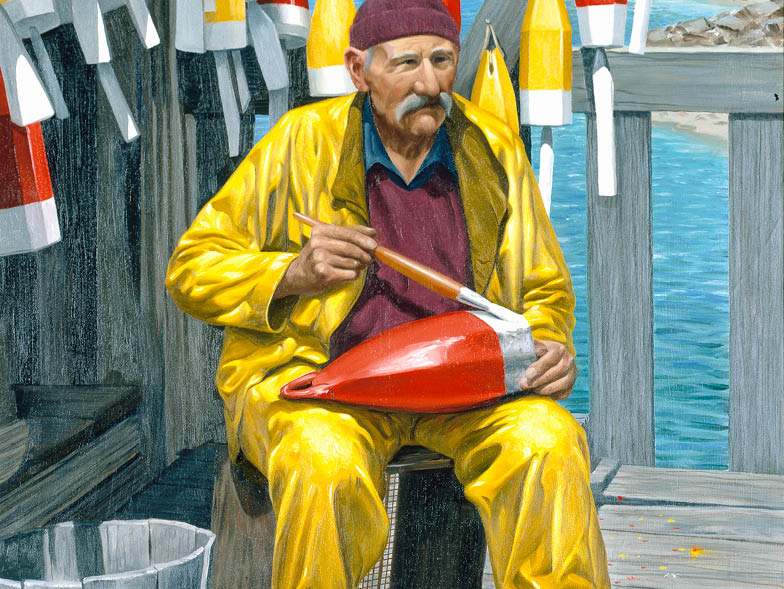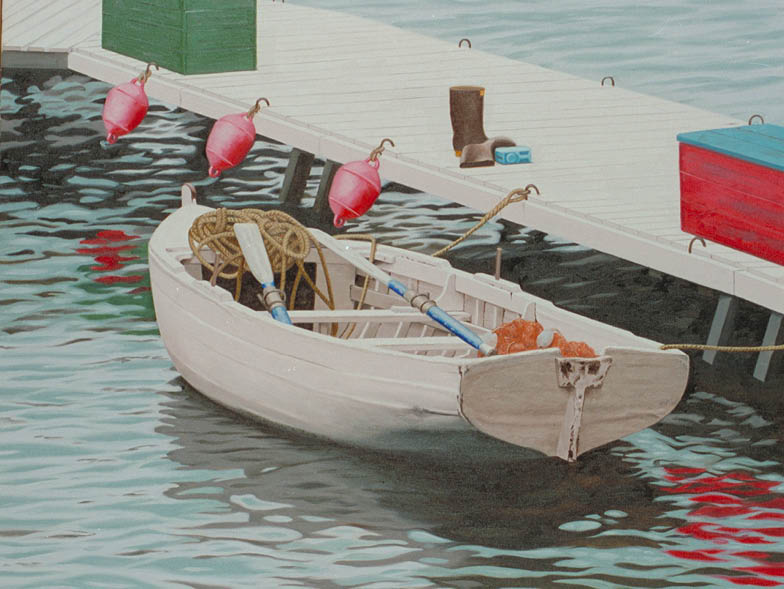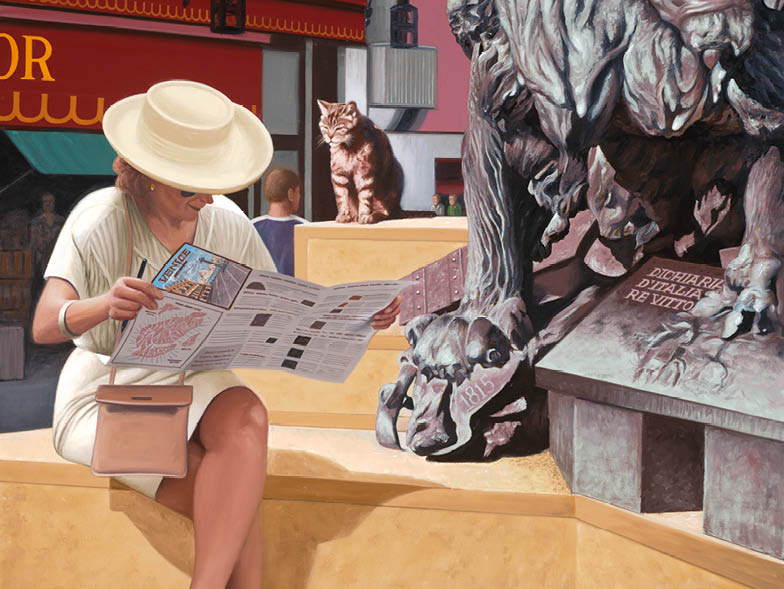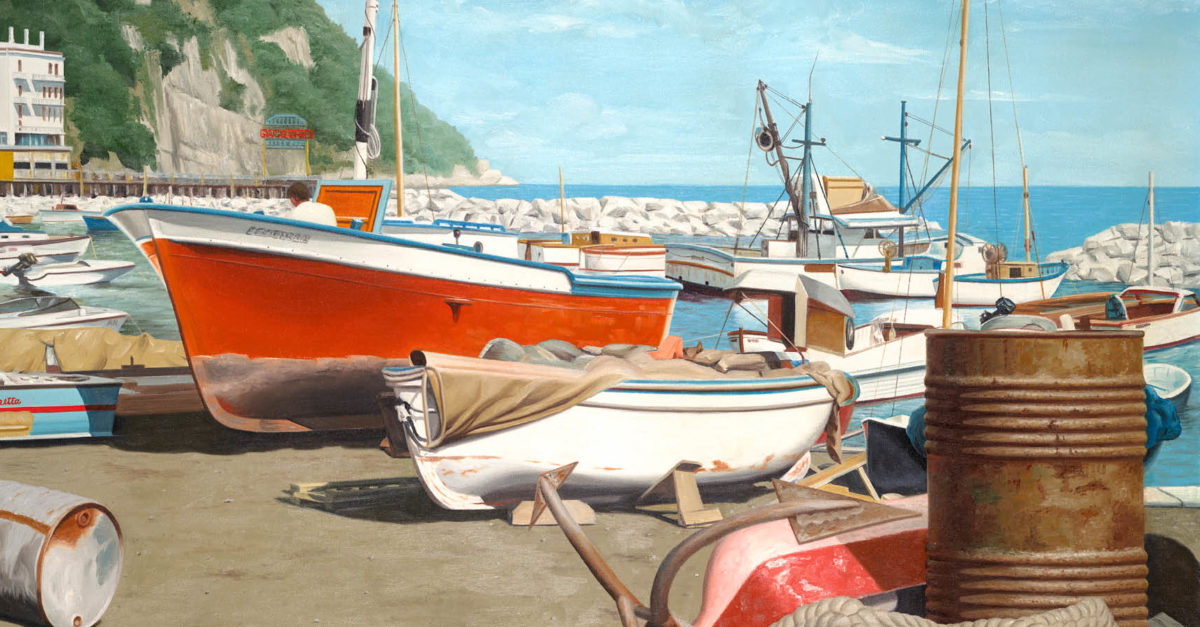The Composition of Ralph Garafola
Brooklyn-raised artist, educator, and author Ralph Garafola has been a commercial illustrator and painter for over sixty-five years, beginning as a draftsman creating technical drawings in the city. After returning home from the army, he became a commercial illustrator, eventually operating his own studio. These days, Ralph has returned to his first love—painting.

What is your earliest memory of making art?
When I was five years old, friends of my parents had a white piano with two white vases on it. I was fascinated by it and kept drawing it. I did not have any art or drawing tools, so I would draw on brown paper bags using pencils.
You worked as a draftsman and then as an illustrator. Were these jobs gateways into painting, or were you always interested in painting?
I started my career as a draftsman in New York City, but I always wanted to paint. I was in the army for two years as a draftsman as well as a photographer making training films. When I returned home, I became a commercial illustrator because my painting style is realism, and in the 1950s, modern art was popular. As an illustrator, I had to paint everything for product ads and brochures. After fifty years of operating my own commercial studio, I returned to fine art painting.
What is a commercial illustrator, and what kind of work were you doing?
A commercial illustrator is an artist that has to paint everything to his clients’ specifications for advertising purposes. I did illustrations for commercial ads and print literature. My clients included Blue Cross, AT&T, Panasonic, Johnson & Johnson, and Schering-Plough. I created illustrations of their products.
How did you transition from commercial illustrator to painter? Were you painting on your own all this time?
I always painted, but time was limited. When I retired from commercial illustration, I returned to painting and started teaching and writing. I am now working on my second art instruction book, Frank J. Reilly—Outdoor Painting, which is scheduled to be published by the end of 2018. My first book is Frank J. Reilly—The Elements of Painting.
How many different forms of art have you studied or gone to school for? Do you love learning?
I studied fine art—drawing, painting, illustration, and abstract art at the Art Students League (or ASL) in New York City for over seven years as a student of Frank J. Reilly. I became his class monitor (or assistant). I am always interested in learning, and there is always something to learn. If I am not painting or working on my new book, I am reading everything and anything I can find. I always learn something.

Tell us more about Frank J. Reilly:
Reilly was an American painter, illustrator, muralist, and teacher. He was a meticulous professional—he taught fine art as a science. No individual or teacher has contributed as much knowledge of fine art and illustration as Frank J. Reilly.
Reilly was best known for his twenty-nine years of teaching both drawing and painting at the Art Students League. By 1960, when I was his class monitor, he was teaching more than 320 students in morning, afternoon, and evening classes. His theories and motivations have produced many great artists. This list is monumental. Reilly was probably the greatest art teacher in the country.
Reilly taught because he loved to, and his extensive knowledge of art and its craft is why he taught so well. The famous artist, illustrator, and muralist Dean Cornwell once said, “Frank Reilly could teach anyone to draw and paint, provided, of course, you wanted to paint.”
What made you decide to study with Frank J. Reilly? What was that experience like? What is something he said to you that has stuck with you all these years?
Reilly lectured on Wednesday nights at the ASL. After hearing his lectures, I realized he was a great teacher. While studying with Reilly, I knew that I did not have to study with anyone else. He taught what an artist needs to know and how to apply this knowledge to develop your own style and better express your ideas.
The one thing that always stayed with me was the way he taught me how to find relationships. He emphasized the connection between planes and forms that exists on whatever you are painting and how they relate to each other.
I owe him my sincere gratitude. His teaching enabled me to succeed as a fine artist and an illustrator. He was my mentor and a father figure to me, and I have as much respect for him now as I did when I was his student in the 1950s and 1960s.

How would you describe your style of painting? What are your preferred mediums?
My fine art style is contemporary realism. I prefer oils for fine art and watercolor for illustrations.
One of your favorite and most recent pieces is a large portrait of Henry Flagler at his home Whitehall, in Palm Beach, Florida. What was the inspiration for this painting?
When I was in Delray Beach in December of 2015, I visited some art galleries in the region, and I stopped at the Flagler Museum. I was so interested in Flagler’s story, I researched everything I could find. I found several black-and-white photos of Flagler that I used as reference. I even found the details of the first stock certificate so I could include that in the painting.
What drew you to plein air painting?
I like painting outdoors because you paint nature as it is. Plein air painting gives you the experience of painting the values, chromas, and colors the way they exist in nature. Once you have this knowledge and experience of painting outdoors, you can then paint nature in your studio. This knowledge allowed me to paint many of my landscapes and seascapes in my studio.
Where do you find inspiration?
My inspiration comes from scenes that are beautiful and interesting, historic moments, and people. All of my paintings are portraits. Whether my subject is a person, landscape, seascape, still life, or pet, my approach is to portray my subject in its natural environment. It puts the viewer inside the painting. My paintings realistically depict what nature has created. All of my paintings tell a story.
What made you decide to teach art at the age of seventy? What do you hope to instill in your students? What are the most common struggles of your students?
I want to pass along the knowledge and experience I have to younger generations while I can. Many abstract painters lack the knowledge to understand what it takes to make a beautiful abstract painting. A good abstract painting requires good composition, different values, different colors, different chromas, different shapes, and a point of interest, which is called an effect.
My teachings are as Reilly taught—not by category, such as landscape or portraits—but, rather, drawing, painting, and picture making. In my drawing classes, I teach line, pattern, structure, anatomy, drapery, and perspective. In my painting classes, I teach light, shade, color, and brush-handling skills. Picture making involves drawing, painting, and adding composition, and it uses the arrangement of abstract elements to tell a story.
Many students get impatient and want each piece to be a masterpiece. To succeed in the realm of performing arts, like dancing and playing music, one must practice the acquired knowledge. An artist only sees what he or she knows. When you learn to analyze what you intend to draw or paint, you start to see as an artist.

You have fairly diversified subject matter. Does each subject resonate with you for different reasons? Do you focus on one for a while and then switch? Or do you simply paint what comes along?
As an illustrator, I had to paint what clients requested. In my fine art, I paint what I find interesting. I choose to paint different subjects because I find painting the same subject to be monotonous.
What was the catalyst for writing a book? What was the process?
I want to share this knowledge I learned from Frank J. Reilly. Reilly’s method works; I have been using it over sixty-five years and have never found a reason to change it. He taught artists how to be successful. I hope that through my books, this method will be passed along to enable future generations to be as successful. Reilly never wrote a book, but I have been told by fellow Reilly students that this is the book he would have written.
I wrote it from my class notes word for word as I learned it from Reilly. I had to redraw the diagrams so they could be scanned and had help from my family to put it together. I am a traditional guy with paper and pencil in hand— no computers.
Do you think you’ll ever retire?
No. As long as I can see and hold a brush, I will keep painting.
For more info, visit ralphgarafola.com.






















